Music Theory - Lesson #7
LESSON #7 – Minor Scales That Have Flats
Last week I wrote about minor scales that have sharps. In case you missed it here is the link: https://steemit.com/music/@hurtinalbertin/music-theory-lesson-6
This week I will introduce you to minor scales that have flats.
These are simple concepts that you may already understand, but if you find that it is a lot to take in all at once, look it over carefully and don’t move on until you completely understand each concept fully. The objective here is to build a solid foundation of knowledge and build on it. If you forgot something that was covered go back and look it over again.
A scale is a series of notes whose names are in alphabetical order. In the case of the minor scale just like major scales, there are eight notes in the scale. Again, just like major scales, the notes in the scale are numbered from the bottom up and roman numerals are used instead of regular numbers. You may also refer to these numbers as degrees.
All minor scales have a specific pattern of whole tones and semitones which occur in this order:
Minor scales can start on any note but must follow this pattern. Scales can also be called keys because once the key or scale of a piece of music is determined, you can derive the chords and melody of that piece of music from the scale. Just like major scales, there are three notes that are very important in the minor scale. They are more important than any of the others, in order if importance they are:
I - The Key Note, Root or Tonic. This note is the scale name.
V- The Dominate Note.
IV - The Subdominate Note.
SCALE OF D MINOR:
To write the scale of D Minor start at D and write a note on each line and in each space until you come back to D.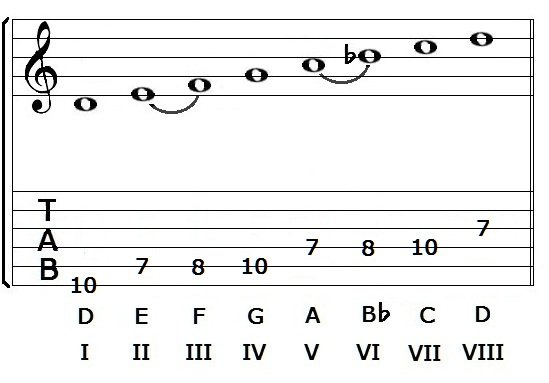
Check the scale you have written against the pattern of whole tones and semitones and you will see that there needs to be a whole tone between the sixth and seventh notes and a semitone between the fifth and sixth notes so the B needs to be lowered to Bb to fit the pattern correctly.
Instead of writing a flat in front of every B in a piece of music in D Minor, the flat is usually written at the beginning of the staff right after the clef sign showing that ALL B’s in the piece of music no matter where they are on the staff must be flat. This is called a Key Signature.
This is the Key Signature of D Minor. Notice the position of the Bb in each clef.
SCALE OF G MINOR:
To write the scale of G Minor start at G and write a note on each line and in each space until you come back to G.
Check the scale you have written against the pattern of whole tones and semitones and
you will see that there needs to be a whole tone between the third and fourth notes and a
semitone between the second and third notes so the B needs to be lowered to Bb.
There also needs to be a whole tone between the sixth and seventh notes and a semitone
between the fifth and sixth notes so the E needs to be lowered to Eb to fit the
pattern correctly.
The Key Signature of G Minor has two flats Bb and Eb as shown below.
SCALE OF C MINOR:
To write the scale of C Minor start at C and write a note on each line and in each space until you come back to C.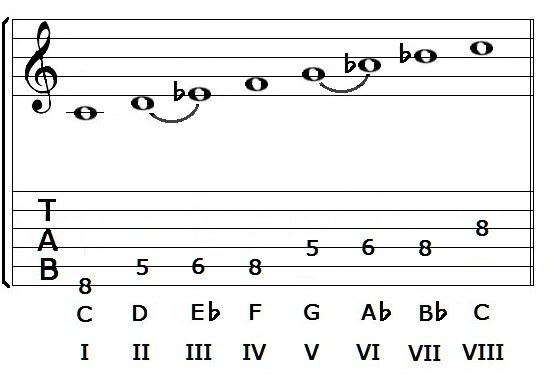
Check the scale you have written against the pattern of whole tones and semitones and
you will see that there needs to be three flats in order for it to fit into the pattern. The
scale of C Minor will have Eb, Ab and Bb.
The Key Signature of C Minor has three flats Eb, Ab and Bb as shown below.
SCALE OF F MINOR:
To write the scale of F Minor start at F and write a note on each line and in each space until you come back to F.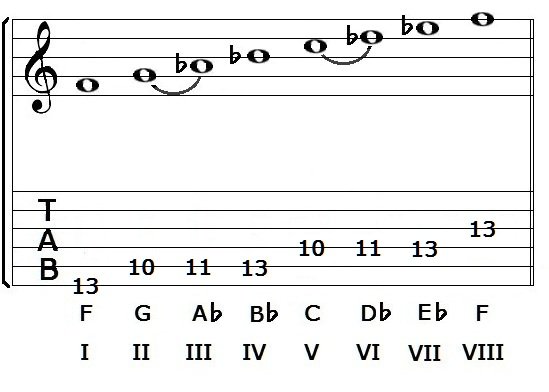
Check the scale you have written against the pattern of whole tones and semitones and
you will see that there needs to be four flats in order for it to fit into the pattern. The
scale of F Minor will have Ab, Bb, Db and Eb.
The Key Signature of F Minor has four flats Ab, Bb, Db and Eb as shown below.
SCALE OF Bb MINOR:
To write the scale of Bb Minor start at B and write a note on each line and in each space
until you come back to B.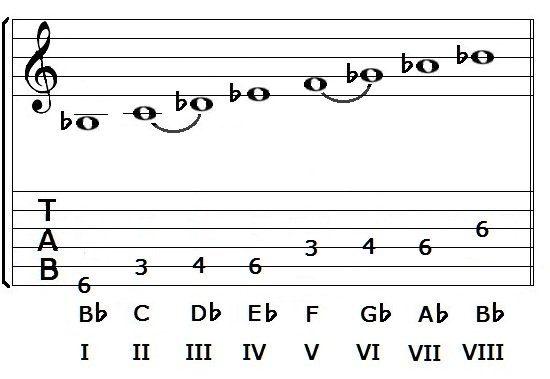
Check the scale you have written against the pattern of whole tones and semitones and
you will see that there needs to be five flats in order for it to fit into the pattern. The
scale of Bb Minor will have Bb, Db, Eb Gb and Ab.
The Key Signature of Bb Minor has five flats Bb, Db, Eb Gb and Ab as shown below.
SCALE OF Eb MINOR:
To write the scale of Eb Minor start at E and write a note on each line and in each space
until you come back to E.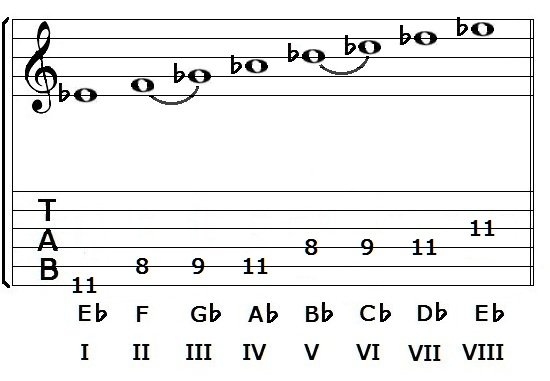
Check the scale you have written against the pattern of whole tones and semitones and
you will see that there needs to be six flats in order for it to fit into the pattern. The
scale of Eb Minor will have Eb, Gb, Ab Bb, Cb and DB.
The Key Signature of Eb Minor has six flats Eb, Gb, Ab Bb, Cb and DB as shown below.
SCALE OF AB MINOR:
To write the scale of Ab Minor start at A and write a note on each line and in each space until you come back to A.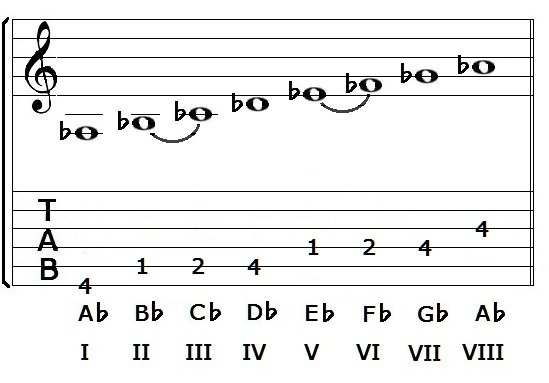
Check the scale you have written against the pattern of whole tones and semitones and
you will see that there needs to be seven flats in order for it to fit into the pattern. The
scale of Ab Minor will have Ab, Bb, Cb Db, Eb, Fb and Gb.
The Key Signature of Ab Minor has seven flats Ab, Bb, Cb Db, Eb, Fb and Gb as
shown below.
RELATED SCALES
Something you should notice about the scales above is that the D Minor key signature is the same as the F Major key Signature, the G Minor key signature is the same as the Bb Major key signature, the C Minor key signature is the same as the Eb Major key signature, etc. This shows that all of the minor scales with flats are related to the major scale that they share the same key signature with.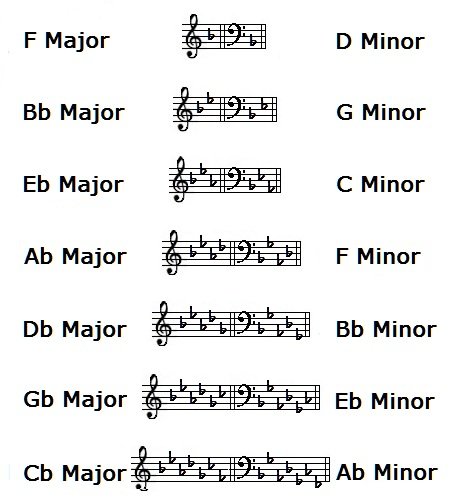
The pictues below show the relationship of each minor scale to its related major scale. If you count to the sixth note of the major scale you will find the name of its’ related minor scale. Also, if you count to the third note of the minor scale you will find the name of its’ related major scale. This works for ALL related major and minor scales with flats.
F Major and D Minor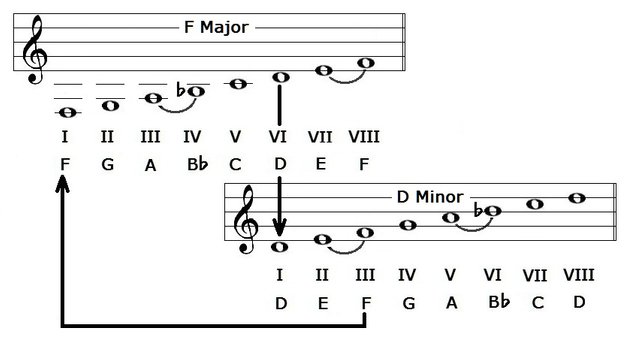
Bb Major and G Minor
Eb Major and C Minor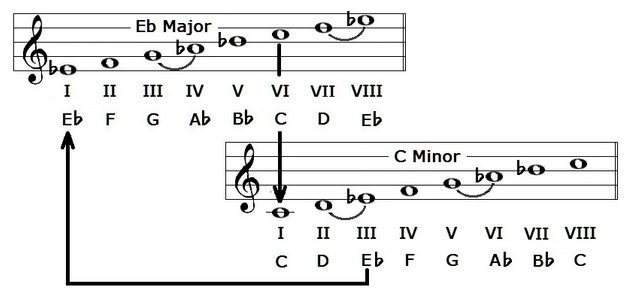
Ab Major and F Minor
Db Major and Bb Minor
Gb Major and Eb Minor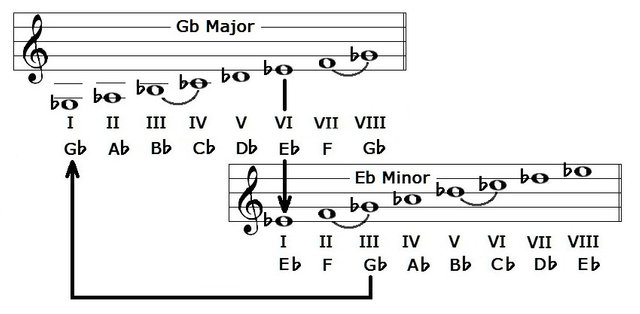
Cb Major and Ab Minor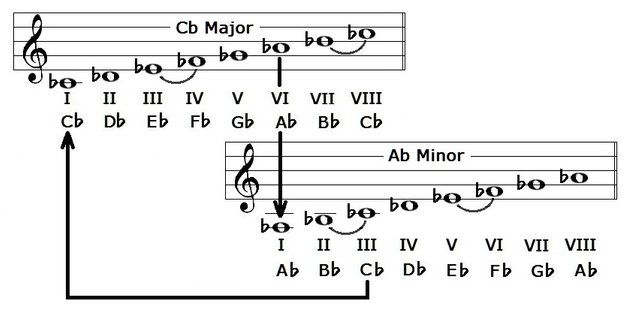
Another pattern you should notice is the patern on the guitar neck for the minor scale.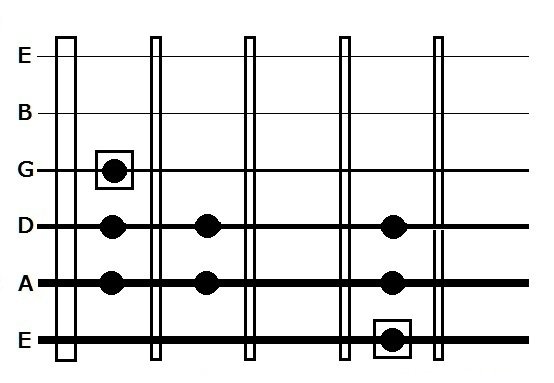
This pattern can be played anywhere on the neck of the guitar and the root or name of
the major scale is the dot with the square around it. So if you were to move this pattern
to where the dot with the square is on the fourth fret, you would be playing the scale Ab
Minor. If you were to move this pattern to where the dot with the square is on the
sixth fret, you would be playing the scale Bb Minor.
This pattern can also be extended to two octaves as below. It is a good idea to memorize this pattern.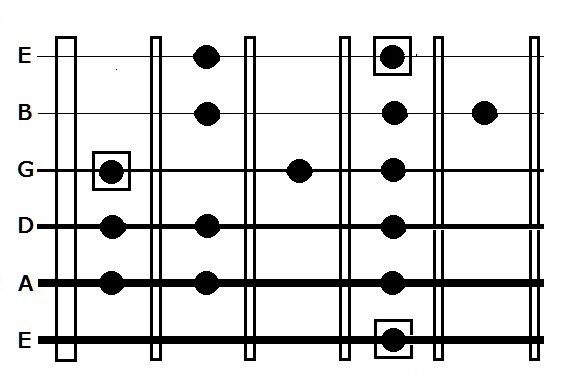
I will stop here and we will continue next week with lesson #8 – More About Scales. Please comment or write questions below I will respond.
Congratulations @hurtinalbertin! You received a personal award!
You can view your badges on your Steem Board and compare to others on the Steem Ranking
Vote for @Steemitboard as a witness to get one more award and increased upvotes!